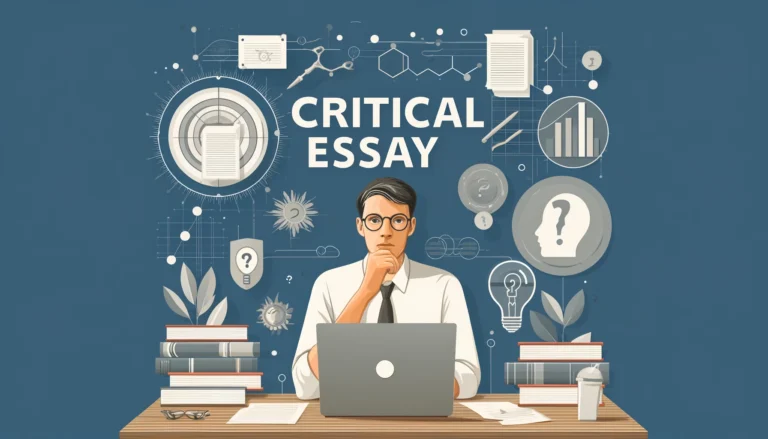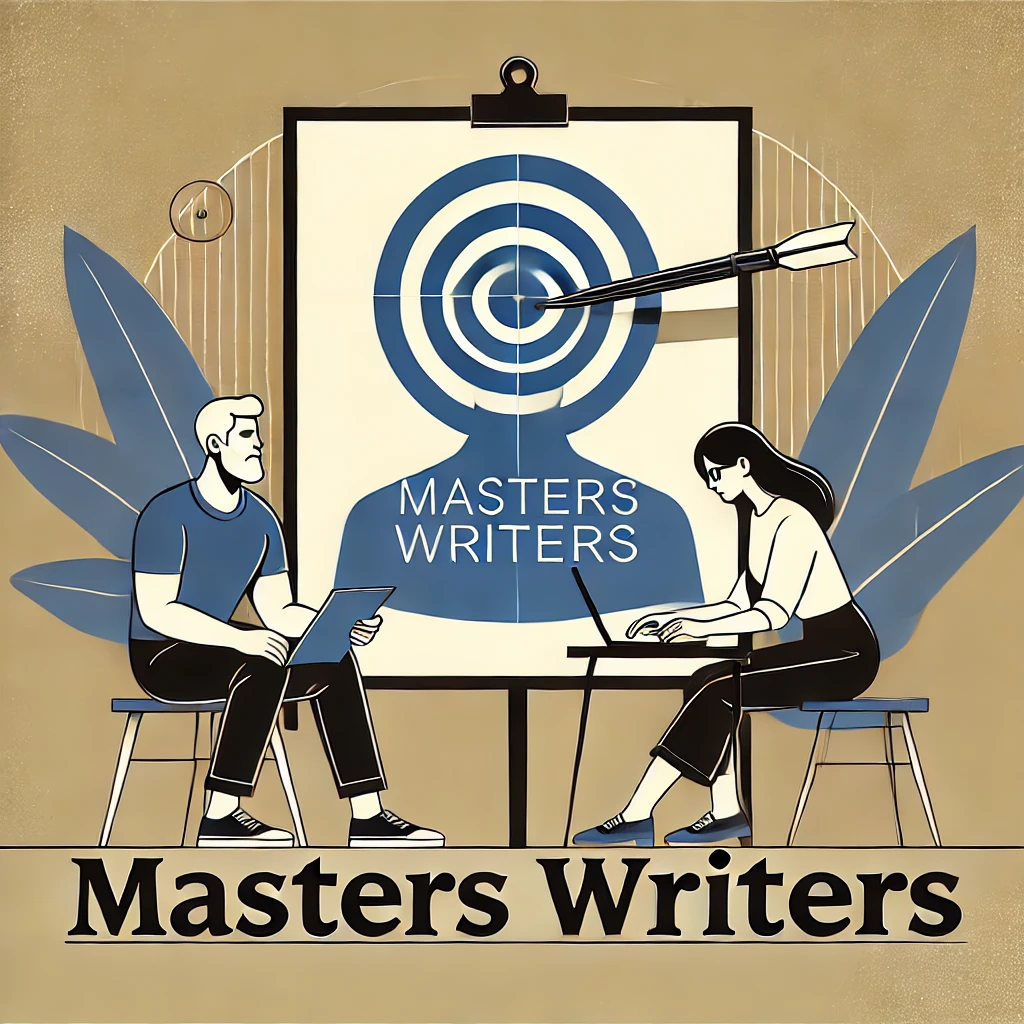Essay Writing Guides
How to Write A Critical Thinking Essay-Examples & Tips


Critical thinking is actively analyzing, interpreting, evaluating, and synthesizing information from observation, experience, or communication. It involves questioning assumptions, identifying biases, and assessing the validity and reliability of information to make well-informed decisions. This cognitive skill is essential for problem-solving and informed decision-making, enabling individuals to approach complex issues with a clear, logical, and objective mindset.
What is a Critical Thinking?
A synthesis essay is a type of writing that requires the integration of information from various sources to form a cohesive, well-argued, and insightful piece. Unlike a simple summary that merely recounts information, a synthesis essay involves analyzing different viewpoints, drawing connections, and presenting a unified argument or explanation. This type of essay often addresses complex topics, demanding the writer to engage with the material critically, evaluate the credibility of sources, and synthesize diverse perspectives into a coherent narrative. A synthesis essay demonstrates the writer’s ability to understand and convey intricate ideas by weaving together information from multiple texts, making it a valuable skill in academic and professional settings.
What is a Critical Thinking Essay?
A critical thinking essay is a form of academic writing that requires the writer to analyze, evaluate, and interpret a subject or issue using evidence and logical reasoning. Unlike other essays that may focus on description or argumentation, a critical thinking essay emphasizes questioning assumptions, identifying biases, and constructing well-supported arguments. The goal is to present a thorough and insightful examination of the topic, demonstrating the writer’s ability to think deeply and critically about the material.

Critical Essay Writing Giving You Headaches?
Save yourself from unnecessary trouble, and let us take care of all your work for you!
The Basics: 8 Steps of Critical Thinking
Mastering the art of writing a critical thinking essay involves understanding the fundamental steps of critical thinking. Here are eight essential steps to guide you through the process:
- Identify the Problem or Question: Clearly define the issue or question you should address in your critical thinking essay. This sets the foundation for your analysis.
- Gather Information: Collect relevant data, evidence, and research from credible sources to understand different perspectives on the topic.
- Analyze the Information: Break down the information into components, examining how each part relates to the whole. Look for patterns, trends, and inconsistencies.
- Evaluate Evidence: Assess the evidence’s credibility, reliability, and relevance. Determine if the information supports or contradicts your initial assumptions.
- Identify Assumptions and Biases: Recognize any underlying assumptions or biases in the information and consider how they affect the analysis.
- Formulate Arguments: Develop clear and logical arguments based on your analysis. Ensure each argument is well-supported by evidence.
- Draw Conclusions: Synthesize the information and arguments to arrive at a well-reasoned conclusion. Ensure your conclusion addresses the original problem or question.
- Communicate Effectively: Present your findings coherently and structured, ensuring clarity and precision in your writing. This is crucial for making a persuasive critical thinking essay.
Following these eight steps, you can develop a robust framework for your critical thinking essay, enabling you to present insightful and well-supported analyses.
5 Steps of Writing a Critical Thinking Essay
Writing a critical thinking essay involves a systematic approach to ensure clarity, coherence, and depth in your analysis. Here are five essential steps to guide you through the process:
- Choose a Thought-Provoking Topic: Select an interesting topic that allows for deep analysis and critical evaluation. Ensure the topic is specific enough to be manageable within the scope of your essay.
- Conduct Thorough Research: Gather information from credible sources, including academic journals, books, and reputable websites. Take detailed notes and organize your research to identify key points and evidence supporting your arguments.
- Create an Outline: Develop a clear and logical structure for your essay. Outline the introduction, body paragraphs, and conclusion. Plan the main points and arguments you will discuss in each section, ensuring a smooth flow of ideas.
- Write the Essay: Begin with a compelling introduction introducing the topic and presenting your thesis statement. In the body paragraphs, critically analyze and evaluate the evidence, presenting well-supported arguments. Use clear and concise language to articulate your points. Conclude by summarizing your analysis and reiterating the significance of your findings.
- Revise and Edit: Review your essay for clarity, coherence, and logical consistency. Check for grammatical errors, typos, and formatting issues. Ensure your arguments are well-supported and the essay effectively addresses the thesis statement. Make necessary revisions to improve the overall quality of your critical thinking essay.
Following these five steps, you can craft a well-structured and insightful critical thinking essay demonstrating your ability to effectively analyze and evaluate complex issues.
Top 50 Critical Thinking Essay Topics
- The impact of social media on mental health
- The role of technology in education
- Ethical implications of artificial intelligence
- Climate change and its economic effects
- The influence of media on public opinion
- The benefits and risks of genetic engineering
- The effectiveness of the criminal justice system
- The importance of freedom of speech in a democratic society
- The role of government in regulating the internet
- The effects of globalization on local cultures
- The relationship between poverty and crime
- The ethical considerations of animal testing
- The impact of advertising on consumer behavior
- The role of parental involvement in education
- The effectiveness of rehabilitation programs for drug offenders
- The influence of corporate lobbying on politics
- The role of renewable energy in combating climate change
- The effects of video games on youth behavior
- The importance of privacy in the digital age
- The impact of immigration on the economy
- The role of art and culture in society
- The implications of universal basic income
- The effectiveness of public health campaigns
- The ethics of euthanasia and assisted suicide
- The role of education in promoting social equality
- The influence of fast food on public health
- The impact of political polarization on democracy
- The benefits and challenges of remote work
- The role of sports in promoting social change
- The effectiveness of international organizations in resolving conflicts
- The impact of tourism on local economies
- The ethical considerations of surveillance technology
- The role of media in shaping body image perceptions
- The effects of socioeconomic status on educational achievement
- The impact of artificial intelligence on job markets
- The importance of cultural heritage preservation
- The role of technology in healthcare
- The implications of space exploration for humanity
- The effectiveness of environmental conservation efforts
- The influence of historical events on contemporary society
- The role of literature in reflecting and shaping society
- The impact of social movements on public policy
- The ethical implications of cloning technology
- The relationship between diet and health
- The effectiveness of mental health interventions in schools
- The role of digital currencies in the global economy
- The influence of educational policies on student outcomes
- The impact of urbanization on the environment
- The ethical considerations of human genetic modification
- The role of social entrepreneurship in addressing global challenges
Critical Thinking Essay Outline
Introduction
- Hook: Start with an engaging statement, quote, or question to capture the reader’s attention.
- Background Information: Provide a brief context or background on the topic to set the stage for your analysis.
- Thesis Statement: Clearly state your main argument or position on the topic. This statement will guide the direction of your essay.
Body Paragraphs
- First Main Point
- Topic Sentence: Introduce the first main point of your analysis.
- Evidence and Examples: Present relevant evidence, facts, and examples to support your point. Cite credible sources.
- Analysis: Critically evaluate the evidence. Discuss its significance, implications, and how it supports your thesis.
- Counterarguments: Address potential counterarguments or opposing views. Refute them with logical reasoning and evidence.
- Second Main Point
- Topic Sentence: Introduce the second main point.
- Evidence and Examples: Provide supporting evidence and examples.
- Analysis: Evaluate the evidence and discuss its relevance.
- Counterarguments: Consider and refute counterarguments.
- Third Main Point
- Topic Sentence: Present the third main point.
- Evidence and Examples: Supply additional evidence and examples.
- Analysis: Analyze the evidence and explain its significance.
- Counterarguments: Address and counter opposing viewpoints.
Conclusion
- Restate Thesis: Reiterate your thesis statement in a new way to reinforce your argument.
- Summary of Main Points: Summarize the key points made in the body paragraphs, emphasizing their importance and how they support your thesis.
- Final Thoughts: Provide closing remarks, including the broader implications of your analysis and any recommendations or insights for future consideration.
References
- Citation of Sources: List all the sources you referenced in your essay, formatted according to the required citation style (e.g., APA, MLA, Chicago).
Critical Essay Examples
FormattingTips
Proper formatting is essential for creating a polished and professional critical thinking essay. Here are some key formatting tips to help you structure your essay effectively:
- Title Page: Include a title page with the essay title, your name, course name, instructor’s name, and the date. Follow the specific guidelines provided by your instructor or the required citation style.
- Font and Spacing: Use a readable font, such as Times New Roman or Arial, in size 12. Ensure your essay is double-spaced, with 1-inch margins on all sides. This makes the text easier to read and leaves space for any annotations or feedback.
- Headings and Subheadings: Use headings and subheadings to organize your essay into clear sections. This helps guide the reader through your arguments and makes the essay more accessible. Follow the guidelines for formatting headings using the required citation style (e.g., APA, MLA).
- Page Numbers: Include page numbers in the top right corner of each page. This helps the reader keep track of the content and makes referencing specific sections easier.
- Introduction and Conclusion: Clearly distinguish your introduction and conclusion from the body paragraphs. The introduction should introduce the topic and present the thesis statement, while the conclusion should summarize the main points and restate the thesis in light of the evidence presented.
- Paragraph Structure: Ensure each paragraph contains a single main idea introduced by a topic sentence. Follow this with evidence and analysis, and conclude with a sentence that ties the paragraph back to your main argument. This structure helps maintain clarity and coherence throughout your essay.
- In-text Citations: Properly cite all sources used in your essay. Use in-text citations according to the required citation style (e.g., APA, MLA, Chicago). This gives credit to the original authors and avoids plagiarism.
- Reference List: Include a reference list or bibliography at the end of your essay, listing all the sources cited in your work. Ensure this is formatted according to the required citation style. This provides the reader with the necessary information to locate your sources.
- Proofreading: Carefully proofread your essay to correct spelling, grammar, or punctuation errors. Ensure your writing is clear and concise and your arguments are logically structured and well-supported.
- Consistency: Maintain consistency in formatting throughout your essay. This includes font style and size, spacing, heading styles, and citation format. Consistency enhances the overall readability and professionalism of your essay.
By following these formatting tips, you can ensure that your critical thinking essay is well-organized, easy to read, and professionally presented, which will help you effectively communicate your analysis and arguments.
Final Thoughts
In conclusion, mastering the art of writing a critical thinking essay is a valuable skill that involves analyzing, evaluating, and synthesizing information to form well-supported arguments. This process requires a deep understanding of the topic and the ability to question assumptions, identify biases, and present logical conclusions. By following the steps outlined in this article, from understanding the basics of critical thinking to structuring your essay effectively, you can develop a compelling and insightful essay that stands out in academic and professional settings.

Essay Deadline Just Around the Corner?
Streamline the writing progress with our expert service!
FAQs
What is critical thinking in an essay?
Critical thinking in an essay involves carefully analyzing, evaluating, and synthesizing information to form a well-reasoned argument or conclusion. It requires questioning assumptions, identifying biases, and examining evidence to support your claims. In a critical thinking essay, you are expected to present information and critically assess the validity and reliability of the data, offering a deep and insightful perspective on the topic.
What is critical thinking in a short paragraph?
Critical thinking in a short paragraph means concisely analyzing and evaluating a particular idea or information. It involves questioning the assumptions behind the information, considering alternative viewpoints, and providing a reasoned judgment or conclusion. The goal is to demonstrate a clear understanding of the topic and the ability to think logically and critically about it.
How do you start writing a critical essay?
To start writing a critical essay, select a thought-provoking topic that allows for deep analysis. Conduct thorough research to gather credible information and different perspectives on the topic. Create an outline to organize your thoughts and structure your essay logically. Start with an engaging introduction that presents the topic and your thesis statement. Then, proceed with well-structured body paragraphs that critically analyze the evidence and support your thesis. Conclude by summarizing your main points and restating the significance of your analysis.
What is critical thinking in your own words?
In my own words, critical thinking is the process of objectively analyzing and evaluating information or situations to form a well-reasoned judgment. It involves questioning assumptions, examining evidence, identifying biases, and considering various viewpoints. Critical thinking enables individuals to make informed decisions and solve problems effectively by thinking logically and systematically.

